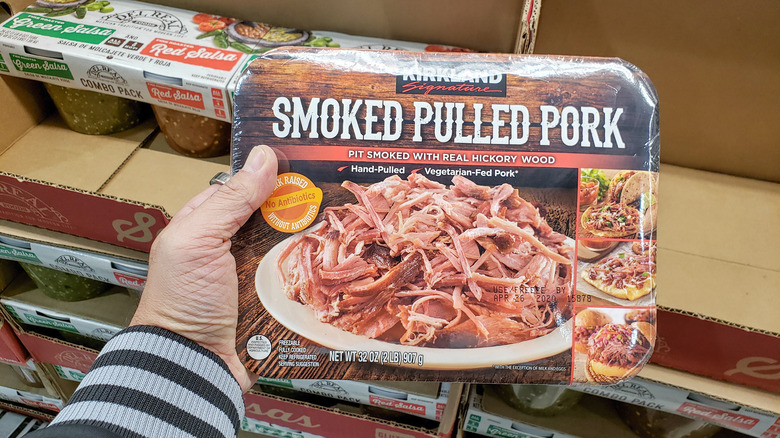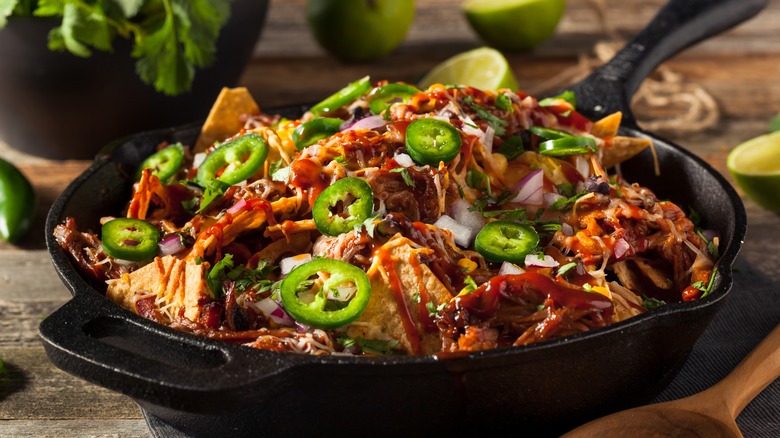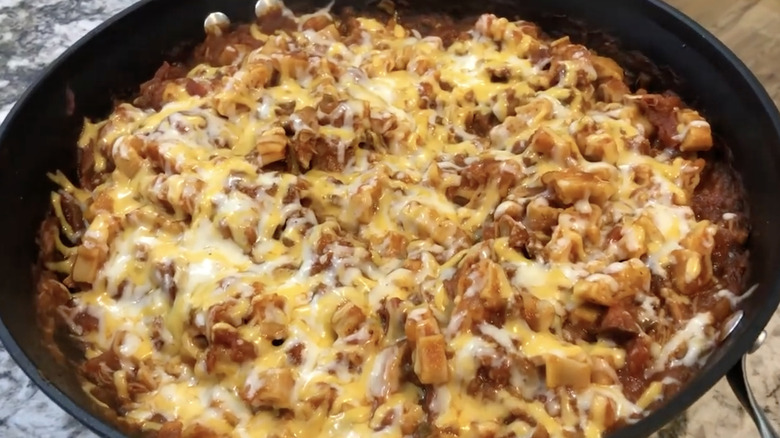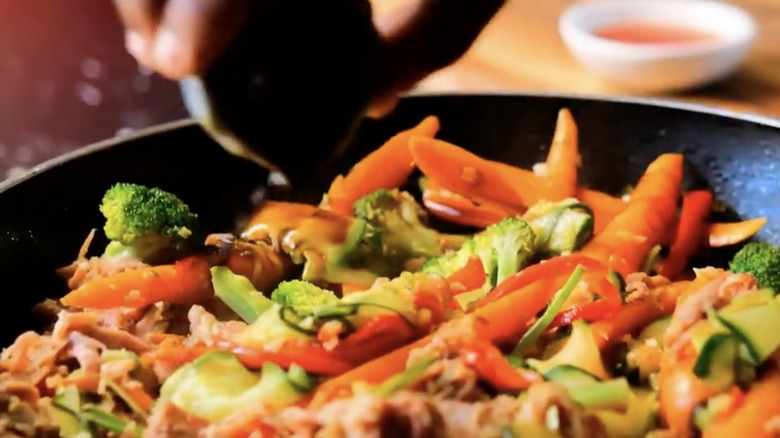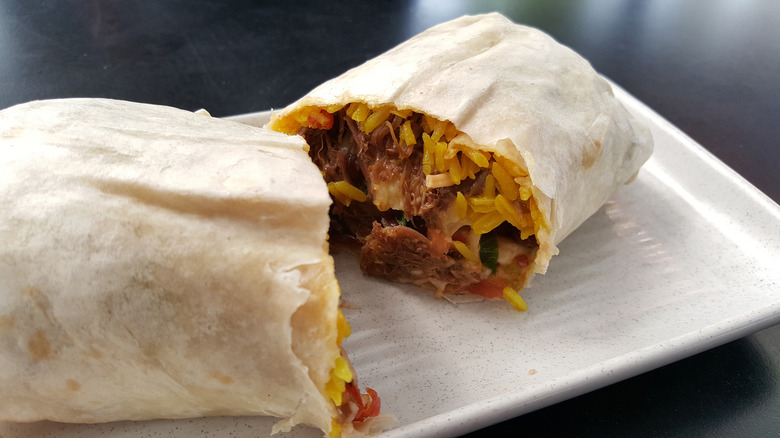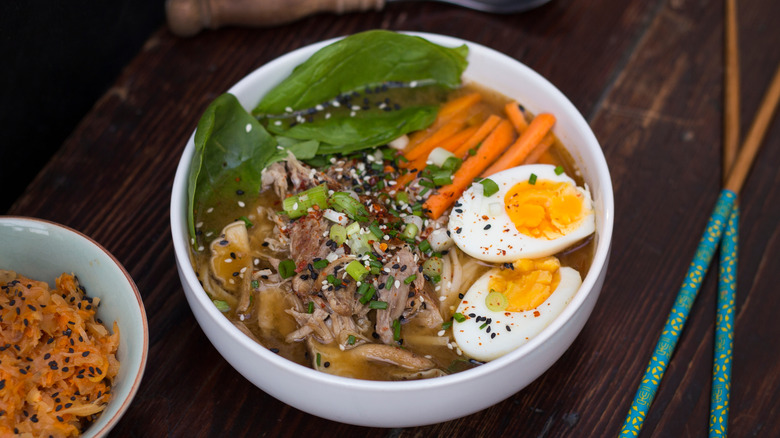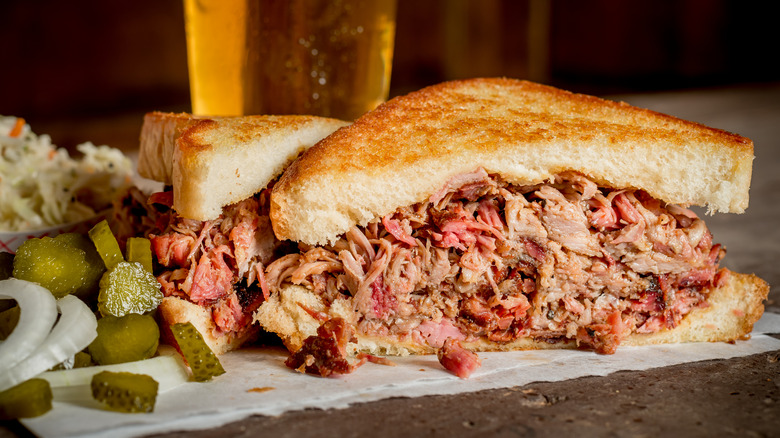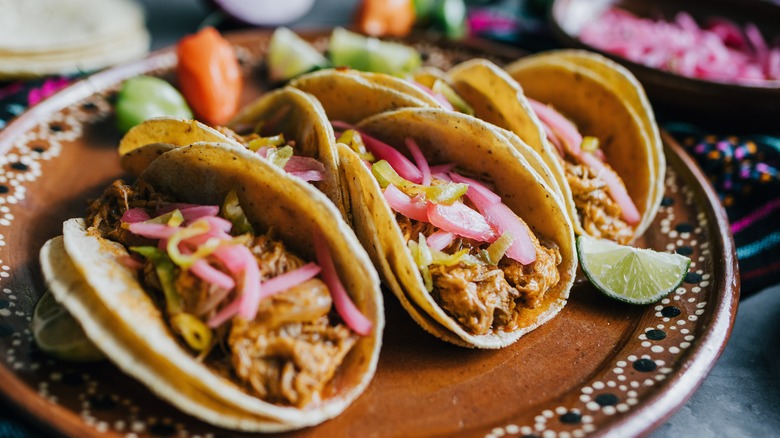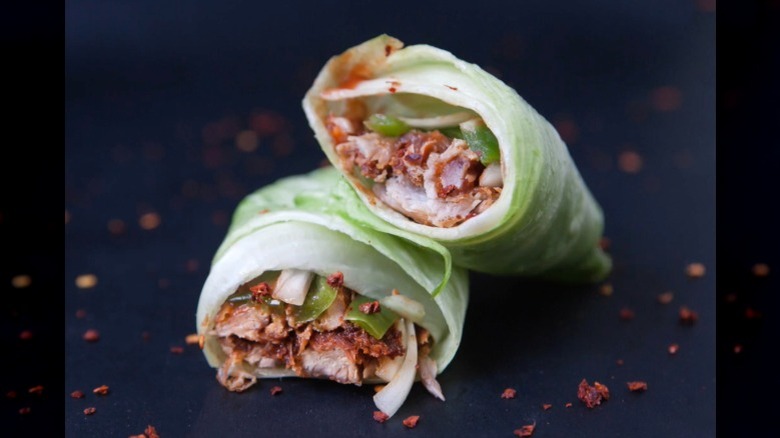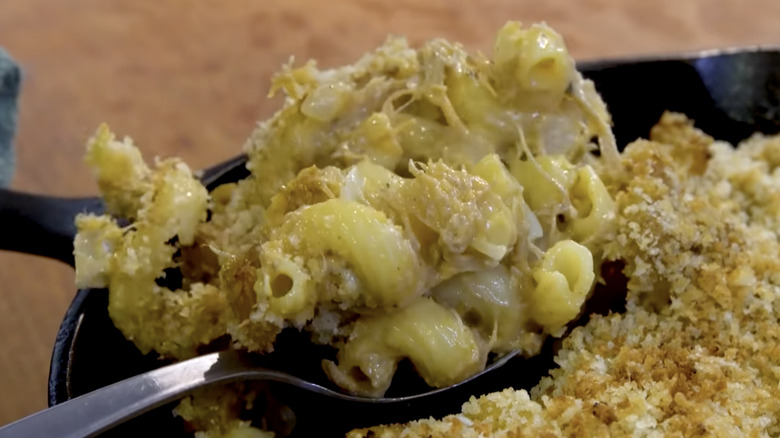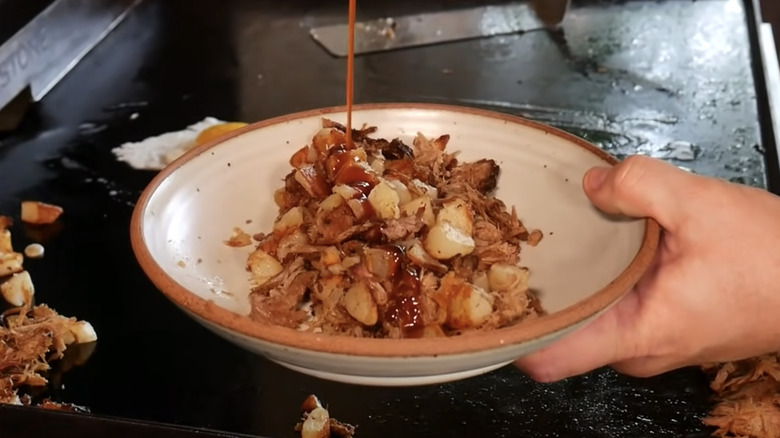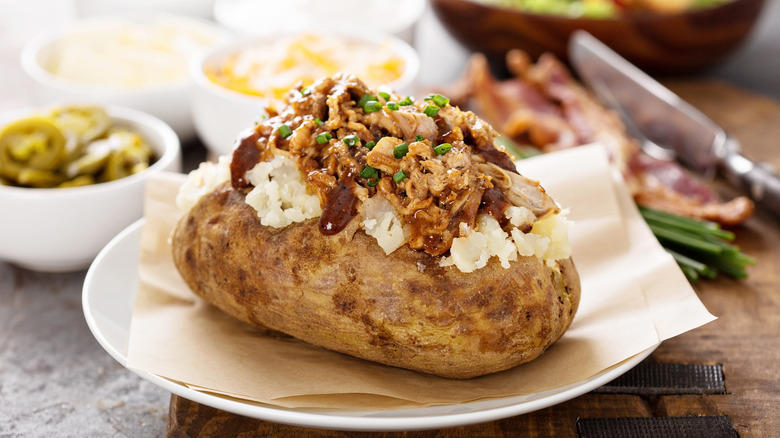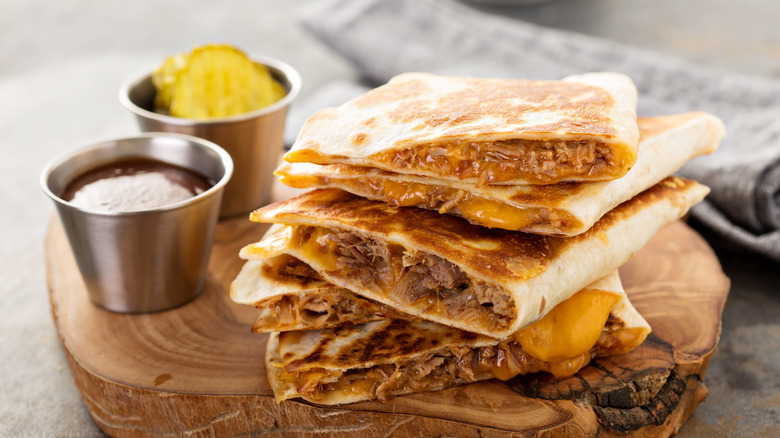13 Delicious Ways To Use Costco's Ready To Eat Smoked Pulled Pork
A quick perusal of Costco's ready-to-eat pulled pork nets you a list of the usual suspects as far as ingredients are concerned: pork, plus rubbings of sea salt, black pepper, garlic powder, the works. All of this is then smoked with hickory flavoring, making a dish that's meant to be delish straight out of the package. But for creative home chefs, this deceptively simple recipe is the building block for fancier meals to come. Part of its flexibility as an ingredient comes from what it is.
Though Costco's brand doesn't say what cut of meat is used, pulled pork generally comes from the pig's shoulder, but you may also see it as pork butt in some recipes. Ironically, this meat is also from the shoulder because, in Colonial times, this cut was crammed into barrels, named "butts," and pork shoulder has been saddled with the name since then. In any event, both of these cuts of meat are tough and would be too tough to eat with any kind of enjoyment were it not for the fact that most pulled pork has been cooked for at least three hours. The lengthy cooking process softens up the meat, making it a logical choice to add to soups and salads, and everything in between. In this piece, you'll get a look at 13 of the yummiest ways to turn this grocery store quick meal into something more.
Top nachos with it
Since their accidental invention in 1943, nachos have always had an everything-but-the-kitchen-sink roster of ingredients on them. That something like pulled pork didn't make it onto the original version of the recipe was due to a lack of ingredients. When restaurant maître d Ignacio "Nacho" Anaya needed to feed some unexpected guests in the Piedras Negras, Mexico restaurant where he worked, he threw together a dish that consisted of corn chips, cheddar cheese, and jalapeños. A dearth of ingredients and an absent cook are why the first order of nachos had only cheese and little else. It also explains why the maître d and not the cook made snacks that night.
In the 21st century, people put more than just cheese, peppers, and tortilla chips on the dish that still bears Nacho's name. Ground beef, shredded chicken, and even pork are common toppings. In light of that, Costco's ready-to-eat pulled pork ought to feel right at home, too. The Kirkland brand meat brings a hickory smoked flavor, encouraging home gourmands to add more creative "extras," like barbecue sauce, pineapple chunks, and cabbage, to the mix. However, nacho traditionalists will probably find that Costco's pork tastes equally good with the likes of avocado, sour cream, olives, and chopped onions, as well as the original three ingredients that brought the dish into the world that fateful day in the 1940s.
Fill your chili with it
Classic chili recipes often call for ground or chunked beef to flavor the stew. However, if you're changing up the status quo, substitute ready-to-eat pulled pork for the ground beef in your spicy chili recipe. The addition of the pork brings a barbecued meat flavor to the mix, without overpowering the recipe entirely. However, if you want a stronger barbecue flavor in the chili, adding your favorite barbecue sauce makes this version of the dish particularly delish.
Pulled pork can dry out if it cooks at temperatures higher than 210 degrees Fahrenheit, so keep an eye on how hot the meat gets before you add the other ingredients. Ingredients like crushed tomatoes, diced fresh vegetables, and broth or water will help maintain the pork's moisture levels. If you use the slow cooker to make the chili, earmark about four hours for cooking time to ensure that the flavors blend properly and that the wet ingredients have a chance to do their magic in the pork.
Create a smoky stir fry
Costco pulled pork, with its smoked hickory essence, infuses your stir fry with the spirit of a Southern barbecue. As with most cooking methods, there is an order of operations when it comes to making good stir fry, and this pulled pork stir fry is no exception. Generally, foods that require the most cooking time must stay in the wok the longest. Meaty veggies, like broccoli or cauliflower, are examples of this.
To get started, wash your vegetables and dry them thoroughly before cutting them. The additional moisture may make the veggies limp instead of crisp during the cooking process. Next, cut your vegetables into small pieces of a fairly uniform size. Be aware, too, that meatier veggies may benefit from being blanched first.
Begin cooking with something savory, like onions or garlic. The pulled pork won't need much cooking. However, if you'd like to flavor your dish with it, drop it into the pan after you've stir-fried the savory ingredients. Remove it once you're done so that it doesn't overcook. Add in the thicker vegetables and allow them to cook. Toss all the ingredients around in the pan to mix everything thoroughly.
Stuff some burritos
Burritos are casseroles wrapped in a flour blanket, and everyone knows that casseroles mean anything goes as far as ingredients are concerned. If anything, making a casserole in a blanket is a good excuse to use leftovers like pulled pork and roasted vegetables. To start, heat the pork in the microwave, nuking it for one to two minutes at a time. Or if you'd rather, heat it in the oven at between 250 and 275 degrees Fahrenheit for half an hour. To warm the tortillas, wrap them in foil and allow them to sit in a 350-degree Fahrenheit oven for around 20 minutes. It's also possible to microwave them in 30-second bursts to ensure they don't become doughy.
Chopped tomatoes, diced avocado, sour cream, onion, black beans, shredded cheese, sliced olives, and Spanish rice usually fill burritos, but you have some flexibility here. Fun ingredients to try include your leftover garlic roasted potatoes, scrambled eggs (if it's morning), chopped shrimp or steak, and roasted vegetables, like broccoli, cauliflower, peppers, and asparagus. Finally, if you're looking for keto options, forego the tortilla and make a pulled pork burrito bowl instead.
Flavor your soup with it
You'll do your favorite homemade soup recipe a favor if you add a little of your Costco pulled pork to it, particularly if you cook it in a Crock-Pot for several hours. Here's why: Inside your soup's spices lurk volatile organic compounds, or VOCs. These compounds burst wide open once you crush or heat the spices. It's also true that the longer you cook something, the more it oozes with flavor, which means the spices in your pulled pork soup come alive.
Additionally, the characteristics of each spice play critical roles in the cooking process. For example, salt makes savory flavor taste all the better. On a related note, cinnamon is a mask for bitterness in food. All of this is to say that the spices that are rubbed all over the outside of your pulled pork and the hickory flavor from the smoking process become enhanced the longer you cook your soup. Every ingredient from the chopped broccoli to the Basmati rice becomes infused with the pulled pork's smoked essence.
Finally, if you'd like to augment the pork's hickory flavor even more, season it with some barbecue sauce. Add the condiment a little at a time to see how it affects the flavor. The idea is that you bring out the characteristics of the hickory that's already in the pulled pork without overwhelming the flavor of the rest of the ingredients.
Add it to your pizza
At its core, pulled pork is slow-cooked barbecued pork. It stands to reason, then, that when you add it to your pizza, you should consider grilling pizza on the barbie to enhance the barbecued flavor associated with this popular meat. Fortunately, modern enhancements make cooking pizza on the grill a simple affair. Although you can bake the pizza on a gas grill, opting for a charcoal-style barbecue filled with hickory augments the pulled pork's original spirit. Adding a plate setter to the barbecue ensures that the temperatures hit the pizza crust in a more even fashion because the plate setter allows the pie to cook over indirect heat. Ideally, you'll get the barbecue to between 400 and 500 degrees Fahrenheit. Once you do, cook the dough for about two to three minutes and flip, adding the pulled pork and other toppings to the other side before cooking for an additional two to three minutes.
For some taste variation, try making the pizza with Alabama white sauce instead of the traditional red stuff. Finally, adorn the pie with zigzags of your favorite barbecue sauce or serve some sauce on the side in a ramekin.
Pack a sandwich for lunch
Taking leftovers to work offers you a delicious way to give your wallet a break and get you through the afternoon hangries at the same time. Sandwiches are usually the meal of choice for most lunch-takers, and your pulled pork leftovers fit this bill nicely. The simplest version of this sandwich includes a bit of mayo on your bread of choice and maybe some mustard. Coating the meat with a bit of spicy mayo is also an option if you're worried about the meat being on the dry side. Just add a dollop of mayo, sriracha (or some other kind of hot sauce from the pantry), ketchup, and the pulled pork to a bowl and mix it before making your sandwich.
Dunking the pork in your favorite barbecue sauce makes for a messy, yet satisfying alternative to mayo. It prevents the meat from drying out, but it's harder to carry along with you for lunch, due to the messiness factor. Your best bet here may be to immerse the meat in barbecue sauce and pack it in a plastic container. Then, assemble it at work. Of course, if you're making your sandwich at home, you don't need to worry about any of this. Just heat up the barbecue pulled pork, pull together your sandwich, and eat with lots of napkins on the ready.
Enjoy pulled pork tacos
Tacos are a meal that is only limited by the confines of your imagination and the ingredients you have in your fridge. Avocados. Mini orange slices. Pulled pork leftovers. Those are all fair game as far as taco stuffings go. While many people have their favorite taco fixings, pulled pork offers a nice alternative to the usual fare because it's so flexible. If you're a traditionalist, top that puppy with chopped green onions, shredded cheddar cheese, olives, avocados, and lettuce.
But if you want to mix it up, break out ingredients like mini Clementine oranges, Asian barbecue sauce, coleslaw, slivered almonds, pickled jalapeños, or Thousand Island dressing. Keep in mind that the type of shell you choose may also bring out the pulled pork's flavor. In other words, a corn tortilla versus a flour tortilla enhances different aspects of the pork's taste, so be sure to experiment with both kinds to see which you like better.
Fill your lettuce wraps with it
Pulled pork plus lettuce wraps is a tortilla alternative that keto lovers will appreciate. The lettuce leaves mimic the tortilla in function while keeping carbs to a minimum. However, it's not just the absence of carbs that makes this such a perfect match. If you've ever eaten lettuce wraps, then you know how frail lettuce is and how easily it falls apart once you bite into it. Pulled pork is soft and tender. It's easy to bite into. In other words, you don't need to worry about biting into the pork with your teeth, which also means you won't shred up its lettuce wrapper in the process. You'll bite as easily through the pork as you will the lettuce.
And you're not limited to just pulled pork in your quest to make the perfect lettuce wrap. Most wrap recipes also include a variety of veggies. Carrots, celery, scallions, chestnuts, cabbage, peppers, cilantro, and more all work well as stuffing options. Heating up the pork is optional, though that could affect the texture and strength of the lettuce wrappers since hot ingredients make lettuce wilt a bit. It might be more comfortable to eat your wraps once everything is closer to room temperature because the lettuce will remain nice and crisp.
Dress up mac and cheese
There's something about a good mac and cheese recipe that just invites you to add ingredients to it. Broccoli. Peas. Tuna. However, pulled pork might be the ultimate mac and cheese addition if you're trying to up the comfort food factor of the dish. Bacon, which is always a bit of smoky deliciousness, is a common secondary ingredient in mac and cheese, and in this respect, pulled pork makes a nice alternative to adding bacon or another smoked meat to the dish.
Cook the pasta on the stove ahead of time. Add ingredients, like cheese, onions, and other flavors, while the dish is still on the stove. Heating the mac and cheese with pulled pork in the smoker or on a charcoal barbecue with a plate setter filled with hickory chips augments the smoky flavor, though this step isn't necessary. If you decide to finish the cooking process on the grill or the smoker, be sure to transfer the ingredients to a cast iron skillet before you take it from the stovetop to the grill.
Combine pulled pork with breakfast
If you're a big fan of pork at breakfast, there's another kind of pork you should add to your morning meats list: pulled pork. It comes with all the smoky flavor you love from bacon and the tenderness of sausage. And if you'd still like pork with breakfast but aren't in the mood for ham, this barbecued meat might be the substitute you're looking for. But it's more than just its flavor profile that makes it such a smart option for the morning meal. Its pull-apart texture allows home gourmands to easily shred it into omelets or scrambled eggs to add extra flavor and texture to these otherwise simple foods.
Pulled pork also lends itself to breakfasts that fall into the casserole category. Chop up some Costco ready-to-eat pulled pork and sprinkle it into your favorite breakfast skillet. Or wrap up your favorite breakfast ingredients in cozy breakfast burritos. Eggs, tomatoes, olives, potatoes, peppers, onions, black beans, and pulled pork are just a few of the ingredients to fill your own version of a breakfast burrito recipe. And if you've got a hankerin' for hash but have run out of corned beef, try making this breakfast classic with pulled pork instead. Finally, don't be afraid to create your own take on breakfast classics. For example, create your own meal mashup by combining the pulled pork from last night's living room picnic with this morning's eggs Benedict.
Put it on your baked potato bar
A helping or two of pulled pork piled on top of the pillowy goodness of your baked potato wakes up the flavor of this comfort food classic like nobody's business. And if it's tasty on a single spud, imagine how much flavor a bowl of pulled pork would bring to a whole potato bar. Its barbecued flavor profile holds its own against other common potato bar proteins, like ground beef, kielbasa sausage, and chopped chicken, making Costco's pulled pork a natural addition to your potato bar party.
The cooking process infuses this protein with plenty of spices and flavor, allowing pork purists to eat it on their spud sans everything but the pork and ladle of its own juices. However, it doesn't need to be a stand-alone topping. Pulled pork plays well with other ingredients, too. Top your pulled pork spud with a heavy drizzle of your favorite barbecue sauce, chopped green onions, shredded cheese, and Russian dressing to replicate the heartiness and flavor of your favorite sandwich. Or mix pulled pork, ground beef, chopped chicken, and sausage to create your own meat lover's meal.
Finally, use pulled pork as a substitute for flavor combos that call for bacon, Canadian bacon, or ham. In other words, try re-imagining Hawaiian-themed Canadian bacon and pineapple spud as pulled pork and pineapple baked potato, instead.
Build some quesadillas with it
Pulled pork quesadillas save you from the experience that all foodies face at one time or another: The I-forgot-to-take-something-out-for-dinner syndrome. If you have leftover pulled pork, tortillas, cheese, and vegetable odds and ends, then you've got yourself a last-minute dinner that might actually make a better meal than the one you might have originally planned for yourself.
Most people make quesadillas with flour tortillas, but corn tortillas work, too. In fact, the first quesadillas, which came out of Mexico's central and southern regions, featured corn, not flour tortillas, so if you opt for corn instead of flour as your wrap of choice, you're keeping the flavor tradition alive. Add cheese that melts easily, like cheddar, Pepper Jack, or even American, to your quesadilla. Cheeses like these trap ingredients, like your pulled pork, black beans, and hot peppers, in one ooey-gooey flavorful bite after another.
Because cold meat tends to hang onto the refrigerator's chill, think about pushing the pulled pork around in the skillet or giving it a round or two in the microwave for a few minutes before stuffing your quesadilla with it. It's also worth noting that some veggies, like bell peppers and onions, taste better if they've been sauteed first. These steps ensure that all the ingredients in the quesadilla get cooked all the way through. Once it's done, serve the pulled pork quesadilla with a side of your favorite barbecue sauce to enhance the hickory-flavored essence of the pulled pork.
